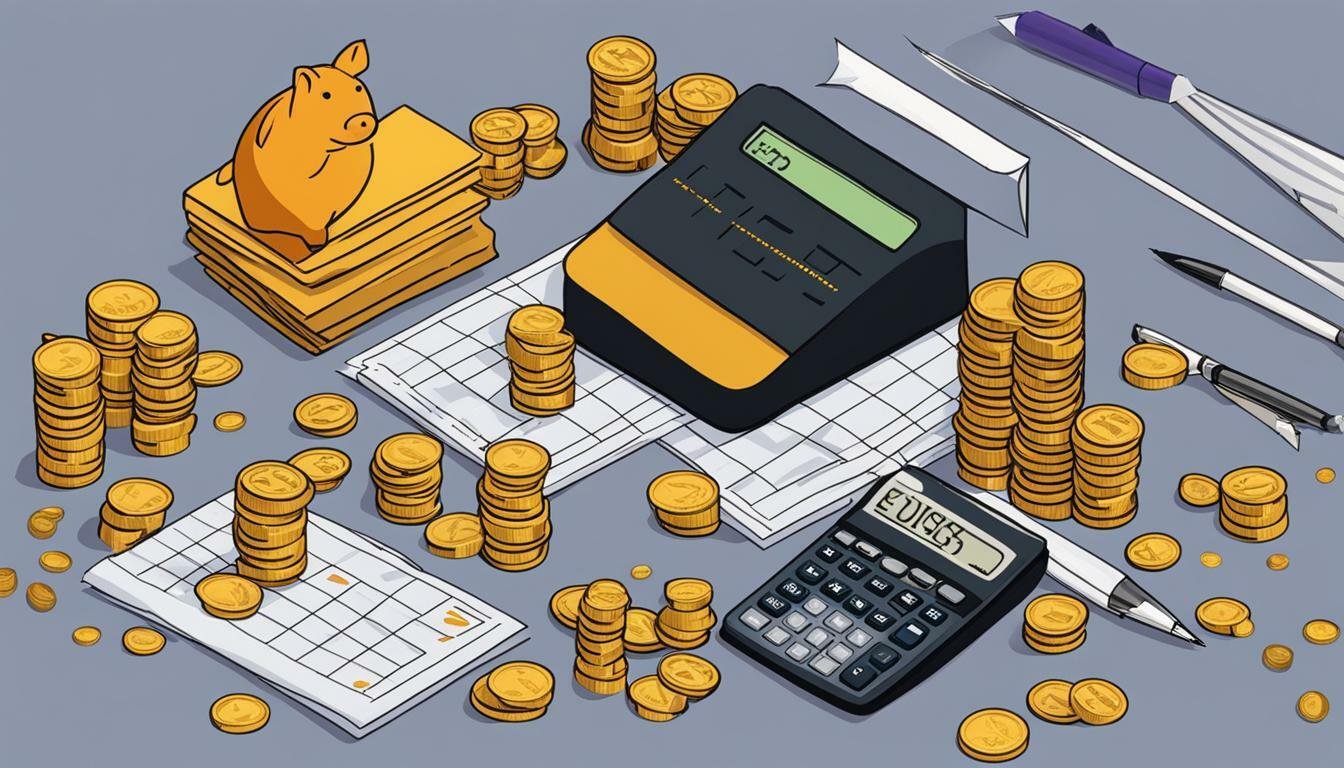Dividend Dilemma: When High Yields Signal Impending Doom
Are you ready to delve into the complex world of dividends and uncover the hidden dangers lurking behind high yields? Brace yourselves, because in this article, we will explore the intriguing phenomenon known as the ‘Dividend Dilemma: When High Yields Signal Impending Doom.’
We’ll unravel the importance of dividends in investments and analyze the relationship between dividend yields and company health. Get ready for a thorough analysis that will empower you to make informed decisions in this volatile market.
Let’s dive in!
Key Takeaways
- High-yield dividends may indicate potential financial distress or mispricing in the market.
- Analyzing the sustainability of dividends is crucial for consistent income.
- Market perception of high-yield dividends can have significant implications for investors.
- Objective analysis of risk factors is essential before making investment decisions.
Understanding Dividends and Their Importance in Investments
Understanding dividends and their importance in investments is crucial for investors looking to maximize their returns. Dividends are a portion of a company’s profits that is distributed to its shareholders. They are usually paid on a regular basis, such as quarterly or annually, and can be in the form of cash or additional shares of stock. Dividends provide investors with a steady stream of income, which can be especially beneficial for those seeking financial freedom.
One of the key reasons why dividends are important in investments is because they allow investors to participate in the company’s success. When a company performs well and generates profits, it often rewards its shareholders by increasing dividend payments. This not only provides an immediate return on investment but also indicates that the company is financially stable and has confidence in its future prospects.
Furthermore, dividends can play a significant role in enhancing overall investment returns. Reinvesting dividends allows investors to take advantage of compounding, where earnings from previous investments generate additional earnings over time. This can lead to substantial growth in one’s investment portfolio.
The Concept of High Yield Dividends
When it comes to investing, there are several factors that contribute to the overall risk associated with a particular investment. These risk factors include market volatility, economic conditions, and company-specific issues.
Additionally, analyzing the sustainability of dividends is crucial in determining whether an investment will provide consistent income over time.
Moreover, the market perception of high-yield dividends can have significant implications for investors as it may indicate potential financial distress or mispricing in the market.
Investment Risk Factors for when High Yields Signal Impending Doom
To gauge the potential risks, we should consider various investment risk factors when evaluating high dividend yields.
The first factor to analyze is the company’s financial health. A high dividend yield might indicate that the company is struggling financially and is resorting to paying out a larger portion of its profits as dividends. This could be a warning sign of impending doom for investors.
Another important factor to consider is the sustainability of the dividend payments. If a company cannot sustain its high dividend payouts in the long term, it may be forced to cut or eliminate them altogether, leading to a decline in stock value and potential losses for shareholders.
Additionally, market conditions and industry trends should also be taken into account when assessing investment risks associated with high dividend yields.
It is crucial to remain objective and thoroughly analyze these risk factors before making any investment decisions.
Dividend Sustainability Analysis
Analyzing a company’s financial health and its ability to sustain dividend payments is crucial in assessing the long-term viability of the investment. To paint a picture for you, here are three key factors to consider when analyzing dividend sustainability:
- Cash Flow: A company’s ability to generate consistent cash flow is essential for sustaining dividend payments. Positive cash flow indicates that the company has enough funds to cover its dividends.
- Debt Levels: High debt levels can limit a company’s capacity to maintain dividend payments. It’s important to evaluate the company’s debt-to-equity ratio and monitor any significant changes over time.
- Earnings Growth: Steady earnings growth provides confidence that a company can continue paying dividends. Consistent profitability demonstrates the strength of its business model.
Considering these factors allows investors to make informed decisions about the sustainability of dividends.
Now let’s explore how this analysis affects market perception implications.
Market Perception Implications About High Yields Signal Impending Doom
Considering market perception implications is important because it can affect the value and attractiveness of our investment. When analyzing the market perception of a particular investment, we must take into account how the general public perceives it.
This includes factors such as brand reputation, customer satisfaction, and public opinion. If there are negative perceptions surrounding a company or its products, it could lead to decreased demand and ultimately impact the value of our investment. Conversely, positive market perceptions can drive up demand and make an investment more attractive.
Therefore, it is crucial for us to thoroughly analyze these perceptions in order to make informed decisions about our investments. By understanding market perception implications, we can anticipate potential risks or opportunities and protect our freedom to choose wisely in the ever-changing financial landscape.
The Relationship Between Dividend Yields and Company Health
You might be wondering how dividend yields can provide insights into the health of a company. Well, let us break it down for you:
- Dividend yields are calculated by dividing the annual dividend per share by the stock price. This percentage represents the return on investment that shareholders receive in the form of dividends.
- A high dividend yield can indicate that a company is distributing a significant portion of its profits to shareholders, which may be seen as a positive sign of financial stability and success.
- On the other hand, an excessively high yield could suggest that the company’s stock price has dropped significantly or that its dividends are unsustainable.
- Additionally, companies with consistently increasing dividends tend to attract more investors and demonstrate strong financial performance over time.
Understanding these relationships between dividend yields and company health allows investors to make informed decisions about their investments. By analyzing trends in dividend yields, potential risks associated with high yields can be identified.
Now let’s explore further by delving into the risks associated with high dividend yields.
Analyzing the Risks Associated With High Dividend Yields
When it comes to understanding dividend yield, there are a few key points that need to be considered.
Firstly, high dividend yields may seem attractive, but they also come with their fair share of risks. It’s important to analyze the company’s financial health and assess whether the high yield is sustainable in the long run.
Additionally, market volatility can have a significant impact on dividend payments, so it’s crucial to understand how these fluctuations can affect your investment strategy.
Ultimately, a thorough analysis of these factors will help investors make informed decisions and ensure sustainable dividend policies are in place.
Understanding Dividend Yield
Understanding dividend yield can be a useful tool for investors looking to assess the potential returns from their investments. It provides insights into how much income an investor may receive relative to the price of the investment. Here’s a breakdown:
- Dividend Yield Formula: Dividend Yield = Annual Dividends per Share / Stock Price
- Comparing Yields: Investors can compare dividend yields of different stocks to identify those that offer higher potential returns.
- Historical Trends: Analyzing a company’s dividend yield over time can reveal its consistency in paying dividends and potential growth prospects.
By understanding dividend yield, investors gain valuable information about potential returns on their investments. However, it is essential to recognize that high dividend yields may also indicate risks associated with unsustainable payouts or underlying financial challenges.
Transitioning into the subsequent section about ‘high yield risks,’ let’s explore the potential dangers that come with chasing high yields.
High Yield Risks
Transitioning into the subsequent section about high yield risks, let’s explore the potential dangers that come with chasing high returns. When it comes to investing, the allure of high yields can be enticing. However, it is important to approach this pursuit with caution. High yield investments often involve higher risks, and understanding these risks is crucial for informed decision-making.
One major risk associated with high yields is the possibility of investment scams or fraudulent schemes. In our quest for higher returns, we may encounter individuals or organizations promising extraordinary gains but end up losing our hard-earned money instead.
Furthermore, high yield investments are often accompanied by increased volatility and price fluctuations. This means that while there may be opportunities for significant gains, there is also a greater chance of substantial losses.
Lastly, companies offering unusually high dividend yields may be facing financial distress or have unsustainable business models. These factors increase the likelihood of dividend cuts or even bankruptcy.
Company’s Financial Health
To assess a company’s financial health, you should focus on indicators such as revenue growth, profitability, and debt levels. These key metrics provide insights into the overall performance and stability of a company.
Here are some specific areas to consider when evaluating a company’s financial health:
- Revenue Growth:
- Look at the trend in revenue over the past few years.
- Analyze if the growth rate is consistent or fluctuating.
- Compare the company’s revenue growth with its industry peers.
- Profitability:
- Examine the company’s profit margin and operating margin.
- Assess if the margins have been improving or declining.
- Consider factors that may impact profitability, such as competition or market conditions.
- Debt Levels:
- Evaluate the company’s debt-to-equity ratio.
- Determine if it has manageable levels of debt or excessive leverage.
- Assess how effectively the company is managing its debt obligations.
Market Volatility Impact
The market’s volatility has had a significant impact on our company’s financial performance. Over the past few months, we have witnessed extreme fluctuations in stock prices, causing uncertainty and affecting our bottom line. The erratic nature of the market has made it challenging to predict future earnings and plan for sustainable growth.
Investors seeking freedom may find themselves facing a dilemma when it comes to dividend policies. On one hand, high yields can be attractive, offering the potential for substantial returns. However, these elevated dividends may also signal underlying issues within the company. In times of market instability, companies may resort to increasing dividends artificially to compensate for declining stock prices.
As we navigate this volatile landscape, it is crucial to consider sustainable dividend policies that prioritize long-term stability over short-term gains. By implementing prudent strategies and focusing on fundamental financial health, we can ensure the continued success of our company while providing investors with confidence in their investments.
Transitioning into the subsequent section about ‘sustainable dividend policies’, let us explore some effective strategies that can help strike a balance between rewarding shareholders and maintaining financial resilience.
Sustainable Dividend Policies
Investors should carefully consider the potential risks and rewards of sustainable dividend policies in order to make informed decisions. When evaluating these policies, it is important to analyze various factors that can impact their sustainability.
Here are three key considerations:
- Company Financial Health: Assessing a company’s financial strength is crucial to determine if it has sufficient cash flows and profitability to support dividend payments over the long term.
- Industry Dynamics: Understanding the industry dynamics is essential as certain sectors may be more prone to economic downturns or disruptions, affecting their ability to maintain dividends.
- Dividend Payout Ratio: Examining the dividend payout ratio helps investors gauge how much of a company’s earnings are being returned to shareholders. A high ratio could indicate an unsustainable payout policy.
Interpreting the Warning Signs of Impending Financial Doom
When it comes to investing, it’s crucial for us to be able to spot high yield traps in order to avoid potential financial pitfalls.
One effective way to do this is through debt ratio analysis, which helps us evaluate a company’s ability to manage its debts and generate profits.
Understanding earnings reports can provide valuable insights into a company’s financial health and stability.
Spotting High Yield Traps
Spotting high yield traps can be challenging, but you should trust your instincts and thoroughly research the investment before making a decision. With that in mind, here are some key points to consider when evaluating potential high yield investments:
- Historical Performance: Analyze the company’s dividend history over an extended period. A sudden spike in dividend yield may indicate financial distress rather than a sustainable return.
- Payout Ratio: Evaluate the percentage of earnings paid out as dividends. If it exceeds 100%, it could imply that the company is dipping into reserves or taking on debt to maintain its payout.
- Industry Comparison: Compare the dividend yields of similar companies within the sector. A significantly higher yield compared to peers could be a red flag.
Debt Ratio Analysis
Analyzing the debt ratio can provide valuable insights into a company’s financial health and its ability to meet its obligations. By calculating this ratio, we can determine how much of a company’s assets are financed by debt. This information allows us to assess the level of risk associated with the company’s financial structure.
A high debt ratio may indicate that a company has taken on too much debt and is heavily reliant on borrowed funds to finance its operations. This could potentially lead to financial instability and an increased likelihood of defaulting on its obligations.
On the other hand, a low debt ratio suggests that a company relies less on borrowed funds and has a more conservative approach towards financing. This indicates stronger financial stability and an enhanced ability to fulfill its commitments.
Understanding Earnings Reports
Understanding earnings reports can provide valuable insights into a company’s financial performance and profitability. Here are three key points to consider when analyzing these reports:
- Revenue growth: Examining the company’s revenue growth over time can indicate its ability to increase sales and expand its market share. A consistent upward trend suggests strong demand for the company’s products or services.
- Profit margins: Analyzing the company’s profit margins helps determine how efficiently it is generating profits from its operations. High profit margins indicate effective cost management and pricing strategies, while low margins may raise concerns about competitiveness or rising expenses.
- Earnings per share (EPS): EPS measures the profitability of each outstanding share of stock. It is a crucial metric for investors as it reflects the amount of money they will receive for each share owned. Increasing EPS signals improved financial performance and potential returns for shareholders.
Case Studies: When High Dividend Yields Predicted Corporate Troubles
In some cases, high dividend yields have accurately predicted corporate troubles. It may seem counterintuitive that a company with a high dividend yield could be in trouble, but it can actually be a warning sign for investors. When a company is struggling financially and its stock price has fallen significantly, the dividend yield will naturally increase as a percentage of the lower stock price. This can attract investors looking for high yields, but it also indicates that the company may not be able to sustain its dividend payments in the long term.
Let’s take a look at some case studies where high dividend yields signaled impending doom for companies:
| Company | Dividend Yield (%) | Troubles |
|---|---|---|
| XYZ Corporation | 10% | Declining sales and mounting debt |
| ABC Inc. | 12% | Legal disputes and regulatory issues |
These examples highlight how high dividend yields can indicate underlying problems within a company. Investors need to carefully analyze the financial health of a business before solely relying on its dividend yield as an indicator of profitability or stability.
It’s essential to remember that while high dividends may initially seem enticing, they often come with risks. Conducting thorough research and understanding a company’s financial situation is crucial before making any investment decisions.
Strategies for Investors to Safeguard Against High Yield Risks
In this discussion, we will explore strategies that investors can employ to safeguard against the risks associated with high yields.
Recognizing high yield traps is crucial in order to avoid investing in companies that may be facing financial troubles.
Additionally, portfolio diversification strategies and effective risk management techniques will be examined as ways to mitigate potential losses and maximize returns.
Recognizing High Yield Traps
Be cautious when evaluating high yield investments, as they can often be deceptive and lead to financial losses. While the allure of high returns may be tempting, it is essential to conduct thorough analysis before making any investment decisions.
Here are three key factors to consider when recognizing high yield traps:
- Unsustainable dividend payouts: Beware of companies that consistently offer exceptionally high dividends compared to their earnings. Such companies may be using the dividend payments as a strategy to attract investors while masking underlying financial weaknesses.
- Lack of diversification: High yields from a single investment source can indicate an over-reliance on a particular sector or company. This lack of diversification increases vulnerability to market fluctuations and potential losses.
- Inadequate research: Ensure you thoroughly research the company’s financial health, management team, competitive landscape, and industry trends before investing in a high yield opportunity. Insufficient due diligence can lead to poor investment decisions and unexpected consequences.
Portfolio Diversification Strategies
Now that we’ve discussed the importance of recognizing high yield traps, let’s delve into portfolio diversification strategies.
Diversifying one’s investment portfolio is a critical step in mitigating risk and maximizing returns. By spreading investments across different asset classes, sectors, and geographical regions, investors can reduce their exposure to any single company or industry.
One popular diversification strategy is allocating assets among stocks, bonds, and cash. This mix allows for both growth potential (stocks) and stability (bonds and cash). Additionally, investing in different sectors such as technology, healthcare, finance, and consumer goods provides further diversification.
Geographical diversification is also crucial. Investing globally not only exposes investors to potential growth opportunities in emerging markets but also reduces their dependence on any single country’s economic conditions or political uncertainties.
Effective Risk Management
To effectively manage risk, you should consider implementing strategies that diversify your portfolio across different asset classes and geographical regions. This approach helps to mitigate the impact of market fluctuations and reduces the vulnerability of your investments to any single sector or region. By diversifying your portfolio, you can benefit from potential opportunities in various markets while minimizing potential losses.
Here are three key benefits of implementing a diversified portfolio strategy:
- Reduced Volatility: Diversification spreads your investments across different assets, reducing the impact of any single investment on your overall portfolio.
- Increased Potential Returns: By investing in multiple asset classes and regions, you can tap into a wider range of growth opportunities, increasing the potential for higher returns.
- Risk Management: Diversification helps protect against unexpected events or market downturns by ensuring that not all investments are affected simultaneously.
By diversifying our holdings, we can position ourselves for long-term success in an ever-changing financial landscape.
Now let’s explore the role of dividends in a volatile market.
Future Outlook: The Role of Dividends in a Volatile Market
You should consider the role of dividends in a volatile market to determine their potential impact on your investments. Dividends play a crucial role in providing returns to investors, especially during uncertain times. In a volatile market, where prices fluctuate rapidly and unpredictably, dividends can serve as a stabilizing force for your portfolio.
Dividends are cash payments made by companies to their shareholders as a share of the company’s profits. They are typically paid regularly, either quarterly or annually. During periods of market volatility, dividend-paying stocks can provide investors with a steady stream of income that is independent of stock price fluctuations.
One key advantage of dividends is that they offer a degree of protection against market downturns. Even if the stock price falls, investors may still receive regular dividend payments, which can help offset any losses and provide much-needed stability to their investment portfolios.
Additionally, dividends can also signal the financial health and stability of a company. Companies that consistently pay and increase their dividends over time demonstrate strong fundamentals and confidence in their ability to generate consistent profits.
However, it is important to note that not all companies pay dividends, especially those in high-growth sectors or start-ups reinvesting all earnings back into the business for expansion purposes. Therefore, it is essential to carefully evaluate each investment opportunity based on its unique characteristics and risk profile.
Frequently Asked Questions
How Do Dividends Work?
Dividends work by distributing a portion of a company’s profits to its shareholders. They are typically paid in cash or additional shares. Dividends can provide investors with regular income and are influenced by various factors such as profitability and dividend policy.
What Are the Benefits of Investing in High Yield Dividends?
Investing in high yield dividends can provide attractive returns, but it’s crucial to carefully assess the risks involved. While they may seem enticing, these investments require thorough analysis and consideration to avoid potential pitfalls.
How Can Investors Determine if a Company’s High Dividend Yield Is a Warning Sign of Financial Trouble?
To determine if a company’s high dividend yield is a warning sign of financial trouble, we analyze its financial statements, debt levels, cash flow, and payout ratio. These factors provide valuable insights into the company’s financial health.
What Are Some Common Risks Associated With High Dividend Yields?
Some common risks associated with high dividend yields include potential financial instability, limited growth opportunities, and the possibility of dividend cuts. These factors can indicate underlying problems within a company’s operations and financial health.
Are There Any Indicators or Signals That Suggest a Company May Be Facing Impending Financial Doom?
There are several indicators and signals that suggest a company may be facing impending financial doom. These include declining revenue, increasing debt levels, negative cash flow, and a deteriorating competitive position.
Conclusion
In conclusion, it’s crucial for investors to recognize the potential dangers associated with high dividend yields. These yields may seem attractive, but they can often be warning signs of impending financial doom. Investors can safeguard themselves against high yield risks by analyzing case studies and understanding the relationship between dividends and company health.
However, in a volatile market, it’s important to remain vigilant and constantly reevaluate investment strategies. Remember, ‘ignorance is bliss’ may be a comforting notion, but in the world of investments, knowledge truly is power.

Dr. Lincoln C. Wood teaches at the University of Otago in New Zealand. He is an avid investor and educator. He loves cash flow, income, and dividends when investing. He likes to buy undervalued companies with strong advantages and earnings growth.







